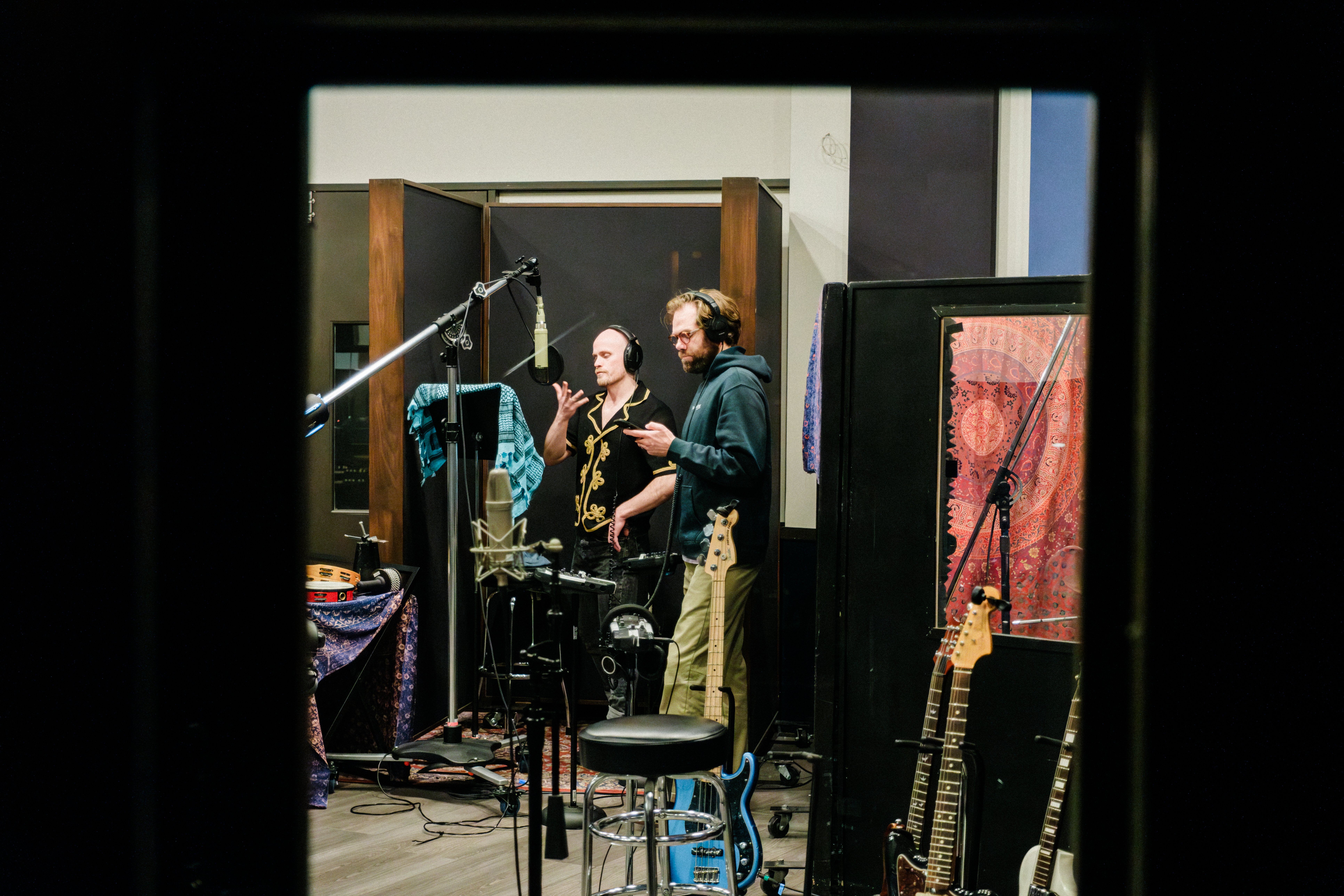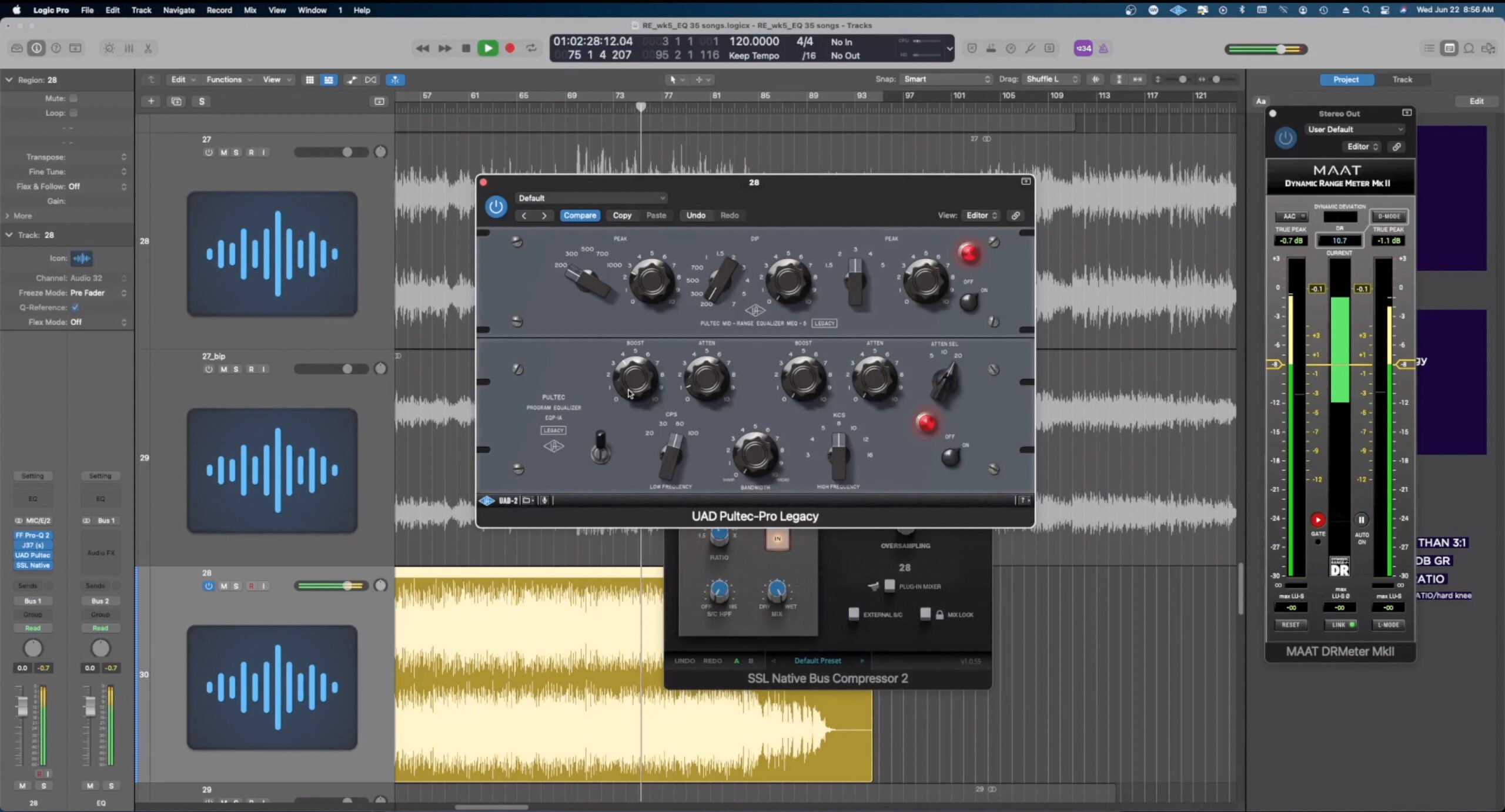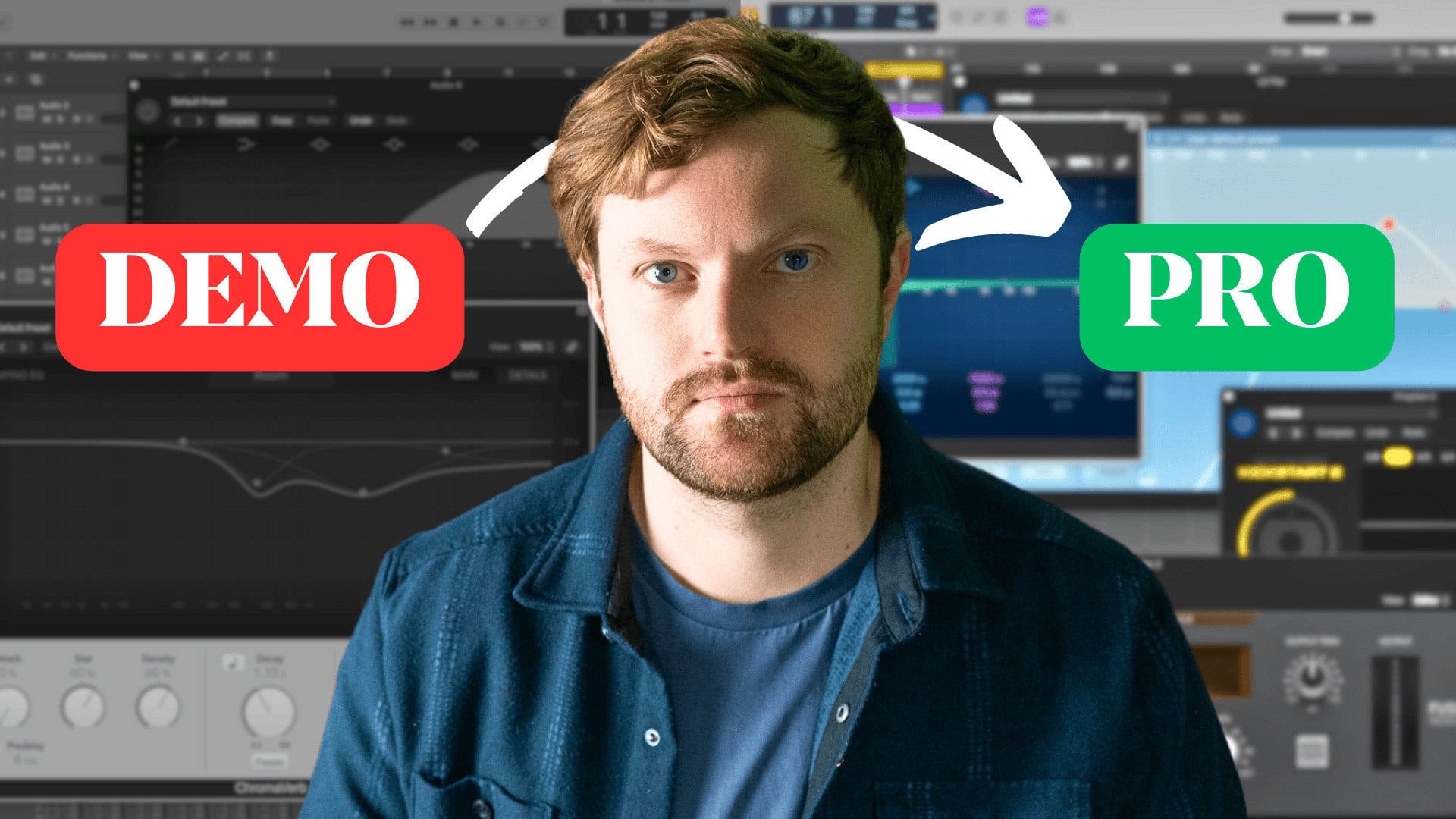Lyrics are one of the most important parts of your song.
They act as an anchor for the song, allowing listeners to strongly identify with you. So you need to do the best you can when writing them!
Today you’ll learn the fundamentals for writing lyrics that last like a mental tattoo.
There’s something irresistible about words set in song.
—Adam Bradley, The Poetry of Pop
The Three Goals of Lyric Writing

You want to write lyrics that are authentic, arresting, and memorable.
Your words should come from the heart. They should be striking and stick with listeners long after the song has ended.
If you hit all three, your lyrics are bound to resonate with your audience.
Today you’ll learn the fundamentals of lyric writing. All these tools will help you write incredible lyrics.
At the very least, I want you to realize that half the copyright of a song is the lyric. So my challenge to you is to spend 50% of the time it takes to create your song on writing those words!
Tip #1: Read Up On Lyrical Trends
Before we dive headfirst into the nitty gritty, let’s take a look at the most common lyrical trends.
Here are some guidelines. Most songwriters follow these to create authentic, arresting, and memorable lyrics.
Lyrics Are Lean: There Are Only a Few Words
Some genres have more, notably rap and folk. But some like EDM will only use a handful.
And those words are usually pretty simple—short with lots of monosyllables.
Lyrics Are Repetitive
Especially in the chorus.
Sometimes the repetition is relentless.
One word or phrase will repeat more than any other. And that will usually be the title…
Uptown (woo) funk you up (come on)
Uptown funk you up (say what?)
Uptown funk you up
Uptown funk you up (come on)
Uptown (woo) funk you up (come on)
Uptown funk you up (say what?)
Uptown funk you up
Uptown funk you up (come on)
Uptown (woo) funk you up (come on)
Uptown funk you up (say what?)
Lyrics Match the Song’s Structure
The words come in patterns that match the structure of the song. The verse lyrics change at the chorus and again at the bridge, if there is one.
The lines within each section usually rhyme at the end.
Lyrics Are Attention Grabbing

Some words will leap out at you, grabbing your attention.
Like a virgin
The first cut is the deepest
I could use some Adderall in my green tea
I will survive
Just a few examples.
Lyrics Can Be Poetic or Everyday
And finally, some of the words will be playful, witty, or cinematic. Used in wonderful ways that might make you think of poetry…
If there’s no one beside you
When your soul embarks
Then I’ll follow you into the dark
While others will be more conversational—things people say every day.
I wanna hold your hand
Although lyrics sound effortless and look simple, it doesn’t mean they’re easy to write.
Tip #2: Starting The Lyric

Each song begins differently. And each songwriter has their own way of getting started.
It may be a word that you read or a billboard you saw out the subway window. And it got you thinking.
Lorde’s song “Royals” was triggered by her seeing the word Royals on a baseball player’s shirt in a photograph in National Geographic.
It may be something someone said to you or you overheard someone say.
Nirvana’s song “Come As You Are” takes a common expression about what to wear and swiftly puts it into a new context.
It may be a situation or an event you think would make a great song.
Anything from the smallest kiss to the sinking of a huge ship. Like Gordon Lightfoot’s “The Wreck of Edmund Fitzgerald.”
You may not have the exact words, but you have a cool idea or story.
It may be a feeling or emotion you want to conjure up. It could be inspired by your own music or just the stuff of life, like James Brown’s “I Feel Good.”
It may be just the sonics of some syllables or words that gets you started.
At this stage, the meaning isn’t critical. They just sound good together, a technique well loved by Paul Simon.
There’s no right way to start.
But once you do, it’s important to record them. So you don’t forget them and can share your progress.
Make sure to back everything up regularly!
Tip #3: Connectivity

Some things that provoke lyrical ideas will be deeply personally expressive. Quite specific to you and your experiences.
A strong lyric will be all that but still feel relevant to other people, often hugely so. That’s called being universal—something a lot of people can relate to.
Lyrics need to connect with an audience and allow them to express emotions that they can’t put into words.
Whatever you’ve got to say has to mean something to the audience, not just you. And they need to care about it.
If they can identify with what you’ve written, you’re in. If they can’t, the audience disconnects and goes back to chatting and drinking in the bar.
Just keep coming back to the overarching theme or point you want your audience to connect with.
What are you trying to say, or what are you trying to do in your song?
It helps to try and explain to a friend—even an imaginary one—what your song is about in a couple of sentences.
My song is about…
Wanting to wait for my partner to deal with some stuff, but feeling frustrated because I don’t want to wait forever!
or
That girl is just so unspeakably hot. I kept crashing my car because I’m so distracted!
or
I want loud music now to escape/ escape/ escape the deep and profound tedium of my current life. Arrrgh!
If you find yourself delivering a lecture rather than a sentence, maybe your idea isn’t quite there yet.
If your friend has an immediate reaction to your idea, that might be a good sign!
Tip #4: Structure

The very practical side of a song being heard as linear audio in real time means that songs have form. Namely a beginning, a middle, and an end.
But songs are short art! You’ve got roughly three or four minutes to get in our hearts and minds.
But anyone who’s been at open mic knows that can sometimes feel like forever! Once you get our attention, you have to keep it!
How you structure your lyrics will help capture and hold us.
The language of fishing is relevant here. A song can be catchy and have a great hook—and that’s not just the music.
Part of your song—the lyrical hook— is a catchphrase.
Like
I can’t feel my face (when I’m with you)
or
Never mind
or
Take me to church
The audience might hear your song in an elevator, a supermarket, or a concert for the first time. Not in a lecture taking notes.
Your opening line is going to be an important first impression. So choose carefully.
Verse lyrics have a different role from a chorus.
They’re often longer, more detailed. Setting up a scenario (who/when/where) in the first verse.
They differ between verse 1 and verse 2, where new information is presented (what’s next/what’s new).
It’s definitely not a case of “second verse same as the first.”
Verse 2 is the next step in the plot or singer’s perspective. Something different happens.
The verses tend to show rather than tell, and they can be alive with sensory details. Tangible specific things we can see and smell, hear, taste, and touch.
They draw us in through imagery, like photographs. Dropping us right in the action, for example Radiohead’s “Exit Music (For a Film).”
Wake from your sleep
The drying of your tears
Today we escape, we escape
Pack and get dressed
Before your father hears us
Before all hell breaks loose
Chorus lyrics, on the other hand, are primed for memorability. With the song title in a spotlit position: the first and last lines are good ones!
Sometimes the chorus is just the title. Whatever you decide.
Repetition is crucial for a memorable chorus. A chorus will likely be heard at least twice in the song but, often, way more.
Here is where emotional heights are scaled or depths are plumbed.
Give us something to feel here! It’s the release after the tension or build up of the preceding verse—the big reveal!
I wanna know what love is!
Tie your lyric as tightly as you can to your melody here because this is the part we want to sing along with. Hopefully after hearing the song only once.
Tip #5: Singability
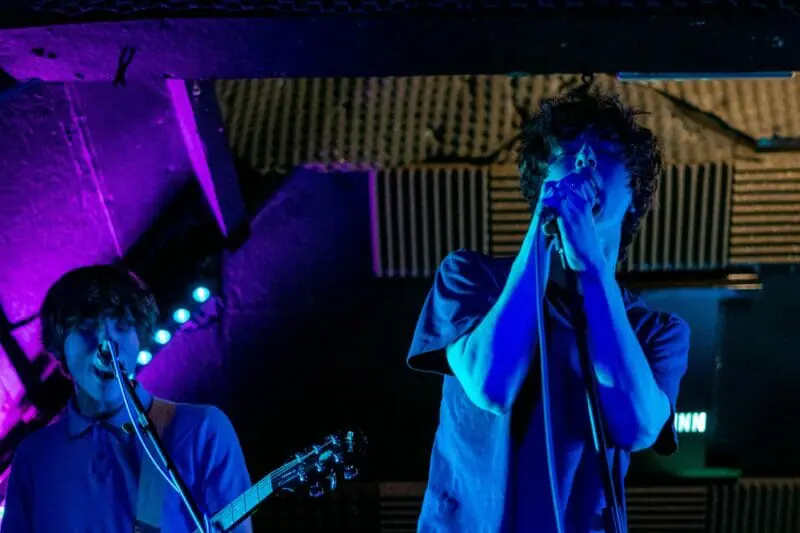
Your lyrics should be singable. These are words to be performed.
Sometimes by great singers. Or the most skilled rappers capable of a mile-a-minute delivery.
These people are virtuosos—the very best in the world.
The vast bulk of your audience won’t be that good. But they still want to join in at your gigs, on the dance floor, or in the privacy of their own shower.
To write lyrics that roll off the tongue, it helps to speak them aloud. It’s a good first step to making sure folks can sing them.
Whatever you have written will have it’s own natural rhythm too.
You can feel which syllables are more stressed or accented than others. For example:
Birth-day
To-mor-row
Com-pose
Lining up words in patterns of stressed and unstressed syllables is called scanning. And it seriously gets a groove going.
Spoken words have their own pitch range, which might help spark the start of a melody. When you’re singing compared with speech, a far wider range is used.
The rhythm of the music changes and exaggerates the context of the most mundane words. Both these factors make words in songs so potentially expressive.
Roughly 90% of the time, singing lyrics is spent on the vowels—a, e, i, o, u. These are sounds you can hold a note on, literally give voice to.
The more important the word, the more emphasis you give it.
But don’t forget the rest of the alphabet.
The consonants contribute to intelligibility of your lyrics. Our understanding of the words sung.
Try singing a lyric with them! Consonants also add pulse, slap, and punctuation to your lines.
And I tread a troubled track
My odds are stacked
I’ll go back to black
Using repeated consonants at the front of words and at the end is called consonance (alliteration), and it’s a type of rhyme. Lining up the same vowels in your lyric is called assonance, and that too is a type of rhyme.
The phrase like back to black does all three techniques.
Black color shows the alliteration in b at the front of back and black. The red shows the assonance of the a. And the blue points out the consonance of the ending ck.
Back to black
You don’t have to use all these features, but it’s no different to changing your EQ or compressor parameters.
So try sculpting your words to make the lips and tongue, teeth, larynx, and lungs have the best time singing!
If you (or your singer) are stumbling over the lyrics, they’re not crafted well enough. Change them to make them flow and allow the singer to breathe too!
Tip #6: Rhyme

Rhyme can be top of mind for frustrated lyricists. Rather than feeling stuck in a rut, think about all the good it does for your song!
1. Rhyme brings rhythm to song. Rhyme has groove.
2. It hooks listeners in.
Almost every pop song has rhyme in it. At the end and sometimes in the middle of each line.
It gives us little dopamine hits, fulfilling our delight in repetition.
We’re even more delighted if the rhyme is unexpected—more ear candy!
3. Rhyming makes songs easier to sing.
4. Rhymes come in patterns called rhyme schemes.
By varying the rhymes in a verse or a chorus, you can subtly offer variation between your song’s sections without changing a single chord.
5. Rhyme makes lyrics more memorable to listeners.
What neither audiences nor songwriters like are overused rhymes. They feel clunky and don’t surprise the listener.
Fret not
Whet your knife and write
The lines of your life
Like your pen is your lover
your best friend’s couch cover
like rhyme
is a fix is a party time
a pig in the middle
and a buzz in the mouth
of the mainstream, right?
Write!
Instead of thinking that rhyme is restrictive, use this framework. It was put together by Professor Pat Pattison of the Berklee School of Music.
He prefers to think of rhyme in terms of closure. The more perfect the rhyme, the stronger the closure.
Professor Pattison organizes rhyme into five types.
The classic rhymes you think of being perfect like fat/cat have the highest degree of closure. Then they go down a spectrum to consonance rhyme like and/bend.
You don’t have to use a word just because it rhymes. Use a word that works!
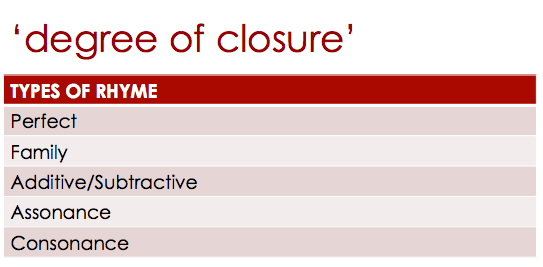
Type 1
The strongest degree of rhyme closure is perfect rhyme. In a perfect rhyme, the end consonant and end vowel sound of two words match exactly.
fat/cat
Type 2
The second-strongest degree of closure is family rhyme. The end vowel sounds match, while the ending consonant sound is a close cousin!
There are three families of consonant sounds:
Plosives: b, d, g, p, t, k
Fricatives: v, z, zh, j, f, th, s, ss, sh, ch
Nasals: m, n, ng
white/snide, spam/can, grooves/snooze
Type 3
The third-strongest degree of closure is additive/subtractive rhyme.
Additive rhyme has a consonant end added to the matching vowel. Subtractive rhyme deletes a consonant end from the matching vowel.
true/hoop, take/stay
Type 4
The fourth-strongest degree of closure is assonance rhyme.
In assonance, the end vowel sounds match, but the end consonant sounds differ. They don’t have to be from the same family.
white/drive, fight/time
Type 5
The least strong degree of closure is consonant rhyme. Consonance means the vowels don’t match, but the end consonants do.
hug/dog
A further tool to try is a rhyming dictionary.
They have suggestions from all the rhyme types. So you can easily find the right word!
Tip #7: Prosody

Your lyrics need to make sense with the music of your song, especially the melody.
This is prosody—the fusing of words and music to make words more impactful.
Every part of your song needs to work together. It should all contribute to the theme, including your lyrics.
Multiple Grammy Award-winning songwriter Jimmy Webb described it like this:
A song is a magical marriage between a lyric (some words) and a melody (some notes). It is not a poem. It is not music. It is in this grey area of synthesis between language, rhythm and sound that some of the most acute of all sensors of human emotion lie.
Prosody makes sure there’s movement through your lyrics, ramping up the drama and tension.
Here are some tips for writing lyrics that match the music!
Avoid Wordiness
Often lyrics written before music are, well, too wordy! Let the music be part of communicating your message too.
Held notes and open spaces are common in melodies.
Chord progressions and groove do a great deal in creating the mood without words.
Structural Variation
Songs aren’t cookie-cutter exercises. The patterns don’t have to be uniform.
If your verse 1 lyrics are short and punchy, try varying verse 2’s lyric line length and rhythm. A little asymmetry can avoid predictability.
Structurally, the verses may vary in length. Verse 2 could be half as long as verse 1.
Rhythmic Variation
Don’t start the melody and lyric together on the first beat of every bar in the verse AND the chorus AND the bridge.
Vary where your lyric enters each part of the song. Between AND within the sections.
This will avoid monotony!
Cut the Chaff
If a particular line or word is weak, delete it. Keep what you think is good.
Record that, including the gaps, and keep it on your phone. It’ll prime your creativity juices to step it up and seek better words.
Look for Inspiration
Study the lyrics of songs that have really moved you. Get under the hood and find out what’s doing the heavy lifting!
Conclusion
The real purpose of the lyrics in a song is to make us feel something.
They can transport us to other realms and transform our moods, even our lives.
This has been an extremely brief round up of how to get started on one of the best jobs in the world. Whatever you can learn to write your own lyrics as well as you possibly can, do it!





